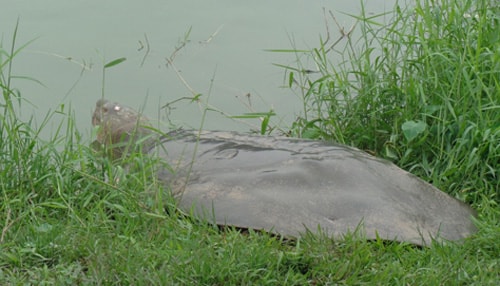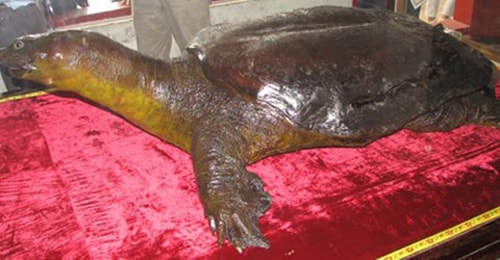The turtle carcass of Hoan Kiem Lake is still preserved in a cold room.
One month after the Hoan Kiem Lake turtle died, its body is still being kept in a cold room at minus 15 degrees Celsius, awaiting a handling plan from the Hanoi People's Committee.
PhDNguyen Trung Minh, Director of the Museum of Nature, affirmed that minus 15 degrees Celsius is the best environment for preserving turtle carcasses, when biochemical conditions are no longer present. The process of creating specimens is not simple, so it needs to be discussed carefully.
 |
The Hoan Kiem Lake turtle while still alive emerged to sunbathe. |
The Museum of Nature and the Department of Science and Technology have sent the Hanoi People's Committee several options for handling turtle carcasses for specimens and are waiting for the city's decision.Three options are proposed: wet preservation, drying and plastination.
Wet preservation is soaking the turtle carcass in chemicals or alcohol. Dry preservation is done the same way as with the turtle in Ngoc Son Temple, that is, making the turtle skeleton and then covering it with a layer of skin. For the fleshy edges on the shell that are easily atrophied, there will be artificial materials to replace them. With the plastination method,Vietnam will invite foreign scientists to discuss.
Talking with VnExpress, tDr. Vu Ngoc Thanh, an animal expert, said that it should be kept dry. Because alcohol and the tank contain extracts that cause discoloration, and the alcohol must be changed and the tank cleaned regularly, the wet method should be reconsidered. The cost of plastination is high, and this is the first time Vietnam has done it, so experts warn that caution is needed.
Associate Professor Ha Dinh Duc, who has spent more than 20 years working with the turtle in Hoan Kiem Lake, agrees with the above opinion. He suggested placing the specimen in Ngoc Son Temple, next to the turtle that died in 2010.
 |
A dried preserved turtle specimen in Ngoc Son Temple. Photo provided by Associate Professor Ha Dinh Duc. |
Previously,The Asian Turtle Program (ATP) believes that it is necessary to clone the Hoan Kiem Lake turtle. To do this, officials need to collectand preserve living tissue samples of animals immediately after death. Tissue samples can be obtained from organs such as the trachea, heart, subcarpal connective tissue, and reproductive organs..However, this method causes many concerns because it is expensive and rarely done in the world.
The turtle in Hoan Kiem Lake died on the afternoon of January 19. In 2011, the turtle was brought ashore to treat its sores for more than 3 months, then returned to the lake, where people released many fish for food. At that time, the turtle's total body length was 185 cm, shell width 100 cm, tail length 35 cm, and weight 169 kg.
The cause of the turtle's death is believed to be old age, because the world's oldest living turtle is 180 years old, while the turtle in Hoan Kiem Lake is estimated to be 200 years old.
According to VNE
| RELATED NEWS |
|---|
